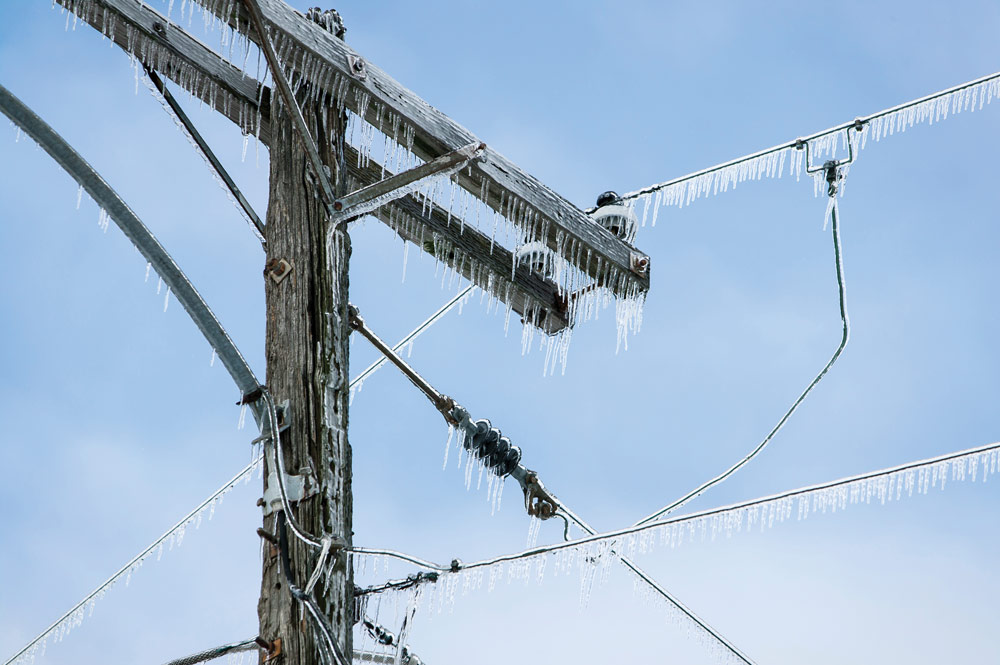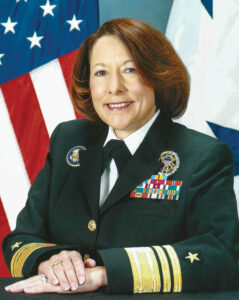 Nancy Brown, or more properly known as Vice Admiral Nancy Brown, U.S. Navy (retired), could be described as a veteran’s veteran.
Nancy Brown, or more properly known as Vice Admiral Nancy Brown, U.S. Navy (retired), could be described as a veteran’s veteran.
Just from her military achievements and accomplishments alone, fellow veterans admire the rural Marion native. But it is her ongoing and unwavering support and service to other former sailors and soldiers that continues to earn her respect.
“I have been so fortunate in my life and career that I believe I need to try to give back,” Brown, 68, explains. “I think now, in some ways, veterans get a lot of attention, but they are still pretty neglected in other ways. There’s a lot of work to be done and whatever I can do to help – to benefit others – I want to try to do that.”
She involves herself in efforts and programs with the same drive and determination evidenced during her more than three decades in the Navy. It was a career that took her to places she never dreamed as a young girl growing up on her family’s Williamson County farm.
“It never occurred to me that I would ever move or travel or really do anything,” she recalls. “Opportunities for women were pretty limited then, so just going to college was unique. I always knew I wanted to go to college, but never thought hard enough about what came after college and what I would do.”
Following graduation from Stephens College with a teaching certificate and a degree in American history, she returned home to find a job.
Trouble was, lots of other new graduates returned, too, and teaching jobs were hard to find.
“I was pretty depressed. One day my dad said to me, ‘Why don’t you join the Navy?’ and the reason he picked the Navy was he thought they had the best food,” she says.
The naval recruiter she visited was less than enthusiastic toward the young lady.
“He told me that the Navy wasn’t for me,” she says, adding his stance was that the service would not take someone with her background. She says she convinced him to submit the paperwork anyway. A call a few weeks later informed Brown that she had been chosen for Officer Candidate School.
“I packed up my little car and headed to Newport, R.I.,” she says. “At that point, I don’t even think I knew that the Navy had ships.”
Brown says her first few months in the service were eye-opening.
“I had no idea what I was getting into. I would talk to my parents and they often asked me what it was like, and all I could say was, ‘It’s different, it’s different.’ In boot camp, I kept thinking about how I had a college degree and there I was scrubbing floors,” she says.
Looking back, Brown says she was fortunate with her first assignment: a placement in communications, working with systems ranging from RADAR and satellite to radio transmissions. Brown says it was as close as she could get to an operational environment in the Navy.
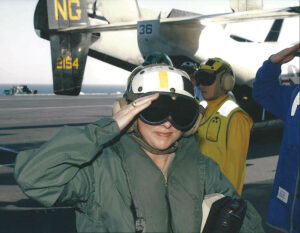 “At that point, women couldn’t serve on ships, so I was as close to the action as I could possibly get,” she remembers.
“At that point, women couldn’t serve on ships, so I was as close to the action as I could possibly get,” she remembers.
Eventually, she did serve onboard naval vessels and got closer to the action. In fact, some would say she was in the heart of it – working in the White House during the Clinton administration.
Her first White House role was to oversee the technical and highly classified communications and intelligence systems that supported the Situation Room. The 5,525 square-foot conference room in the basement of the West Wing is used by the president and advisors during times of potential crises.
“It’s kind of the hub of activity in the White House,” Brown explains. “I was in more of a behind-the-scenes role. We maintained all of the presidential documents and records, but my encounters with the president were pretty limited, although I did brief the senior staff members on what we were doing.”
Her next White House assignment was different.
“With the second appointment, I was the senior military person at the White House and in charge of all military support provided to the president,” she says.
When Brown says all, she means all. She ultimately was responsible for everything from the White House Communications Agency to Camp David (the presidential retreat), from the service men and women who cook meals to valets who personally support the president, and all presidential transportation including motorcades, the presidential helicopter Marine One and the well-known Air Force One aircraft. In all, she oversaw about 5,000 military personnel.
The role also made her a frequent traveler with the president.
“I worked for a civilian who was a political appointee. One of the two of us went on every trip. … Since he was considered more senior, he got the good trips, I got the others,” she says with a laugh. “I’m not complaining, though, it was all fun.”
Brown says the role came with a great deal of responsibility, including occasionally being the bearer of bad news, which she personally had to deliver to the president or his chief of staff.
“If there was a problem with the plane or any military support, I had to explain to him why we couldn’t take off until we fixed it. That was challenging because the president didn’t understand delays.”
Much of her White House assignment involved juggling political desires, requirements of the Pentagon, needs of the president and the Secret Service and simple logistics.
“There was a lot of balancing and trying to do what was best for everybody and then trying to find a way to explain why we couldn’t do it,” she recalls.
Looking back, she says the memories of her nearly four years working on Pennsylvania Avenue are too many to measure.
“It is still hard for me to believe that all of it actually happened to me,” she says. “There are so many stories that I could tell, but I can’t,” she says. “During my time there I always thought, ‘I can’t believe this is really happening.’ I mean, every day, walking into the White House, I almost had to pinch myself.
“It was such a great opportunity to see how our government works and the difference between the way things are done in the military and the political arena. I got insight into why things are done the way they are – all of the planning and effort that goes into things every time the president goes somewhere, even if it just a couple of blocks in D.C.”
After about a year flying on Air Force One and riding in motorcades, the Navy had another destination and rank in mind for then Captain Brown.
“By the time I was given command of a communications station, the Navy decided communications was an up and coming field and they probably should put more emphasis on it. They started looking for someone to oversee communications as an admiral,” she explains. “I was about the only one who had the experience.”
She was selected to be a vice admiral in 2009, one of just 15 female admirals in the branch. The post and her leadership skills led to experiences she will never forget.
“Every disaster we’ve had, it seems I’ve been in the middle of it. I was the first female flag officer on the ground in Iraq; I lived in one of Saddam’s palaces,” she says, about her role in rebuilding the nation’s communications infrastructure. “When [Hurricane] Katrina hit, I was responsible for reconstituting communications. I often thought the only difference between the two was that in Iraq, I was armed.”
With a scrapbook full of experiences, Brown considers herself lucky.
“It wasn’t my planning or forethought, it was luck. I just always seemed to be in the right place at the right time,” she says acknowledging the same fortune during the 9/11 attack on the Pentagon. A meeting she was scheduled to attend when and where the plane hit was moved to a different building just hours before.
Upon retirement in 2009, Brown and husband Peter Hesser, a decorated U.S. Marine, returned to her family’s centennial farm near Marion. She began to look for ways to give back.
“The first thing I got involved with was the VFW and the American Legion, trying to do what I could. Then I became associated with the honor guard rituals team doing funerals.”
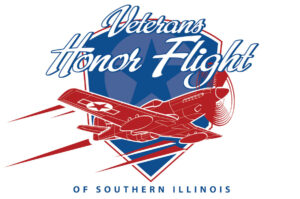 Then, another way of serving called. A member of the Veterans Honor Flight of Southern Illinois reached out to Brown, asking her to help get the program started in the region. There was no way she could say no. The program gives veterans a free day-long trip to the nation’s capital so they can visit memorials and sites which honor them.
Then, another way of serving called. A member of the Veterans Honor Flight of Southern Illinois reached out to Brown, asking her to help get the program started in the region. There was no way she could say no. The program gives veterans a free day-long trip to the nation’s capital so they can visit memorials and sites which honor them.
“I didn’t even know there was an Honor Flight here. I had been involved in other places, so I volunteered and the next thing I know, I’m on the board and I’m working full-time to help. It was a lot of work getting to where we could actually do the first trip. But, I tell you, that morning at the airport, seeing the veterans, how excited they were and interacting with them, hearing their stories, made it all worth it.”
Accompanying the veterans, she continued to give back.
 “When’s the last time an admiral offered to get you water?” she asked the guests, then proceeded to bring each one a bottle of water.
“When’s the last time an admiral offered to get you water?” she asked the guests, then proceeded to bring each one a bottle of water.
Using her skills and contacts, she made the trip special.
“One of the veterans was a Seabee, part of the construction unit in the Navy,” she says. “I asked one of the police officers escorting our bus if we could drive by the memorial for the Seabees and he suggested taking this veteran in the squad car.”
Brown says the veteran rode in the police car to the memorial with lights flashing for a VIP treatment.
“I have pictures of him touching it and he’s in tears. I still get emotional talking about it. To be able to do something like that is very special,” she adds.
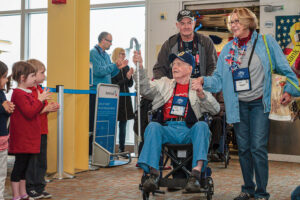 Doug Kimmel, director of the aptly named Veterans Airport of Southern Illinois and a member of the board of directors for the area’s Honor Flight organization, says having Brown work with Honor Flights is extremely valuable.
Doug Kimmel, director of the aptly named Veterans Airport of Southern Illinois and a member of the board of directors for the area’s Honor Flight organization, says having Brown work with Honor Flights is extremely valuable.
“Nancy has been instrumental in propelling the Veterans Honor Flight of Southern Illinois forward after our initial formation,” Kimmel says. “What she brought to the table in terms of her leadership, knowledge and willingness to put forth time has been amazing.”
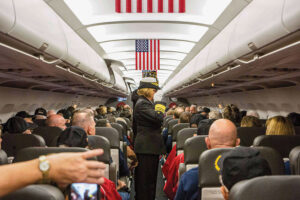 Kimmel continues, “She has been instrumental in our program, from fundraising to the logistics of everything, especially in Washington, D.C. What is most memorable to me is the respect and admiration the veterans themselves have for Nancy – a respect and admiration that she has for them, too.”
Kimmel continues, “She has been instrumental in our program, from fundraising to the logistics of everything, especially in Washington, D.C. What is most memorable to me is the respect and admiration the veterans themselves have for Nancy – a respect and admiration that she has for them, too.”
For Brown, soldiers and sailors come first. It was that way when she was in command and continues to be at the forefront as she volunteers.
“One of the things I always did was visit my sailors at odd hours,” she says. “They often saw me scrubbing floors or doing something they were doing. I tried to pitch in and see what life was like for them. It was important for me to stay in touch and not get disconnected. I wanted to know what I could do to help them make life better.”
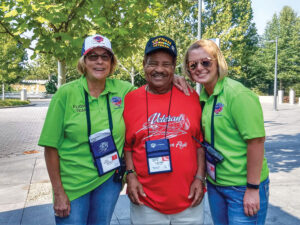 She is still working to make their lives better.
She is still working to make their lives better.
“I think honoring the service that veterans have provided is very important and making sure they feel appreciated,” she stresses. “I have been very fortunate and believe I need to give back.”
Brown has an important message for her fellow veterans.
“I want to thank them for their service. That is not a hollow statement. For me, it’s a thank you to them coming from an understanding of the sacrifices they made. They left everything behind to put on a uniform and serve their country. They went where they were told to go. They did what they were told to do. We all should appreciate the sacrifices they made and realize the impact it had on their lives. It’s significant, and I don’t think many people are able to appreciate what a veteran has really done, but I can.”
To veterans, that’s a salute from a vice admiral.


